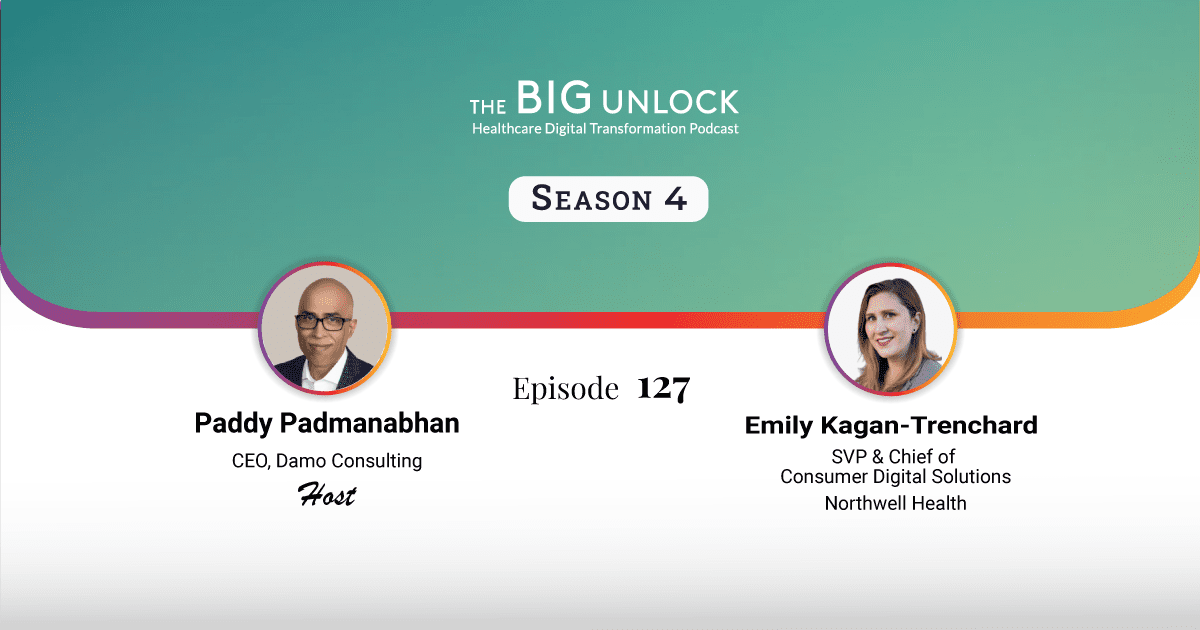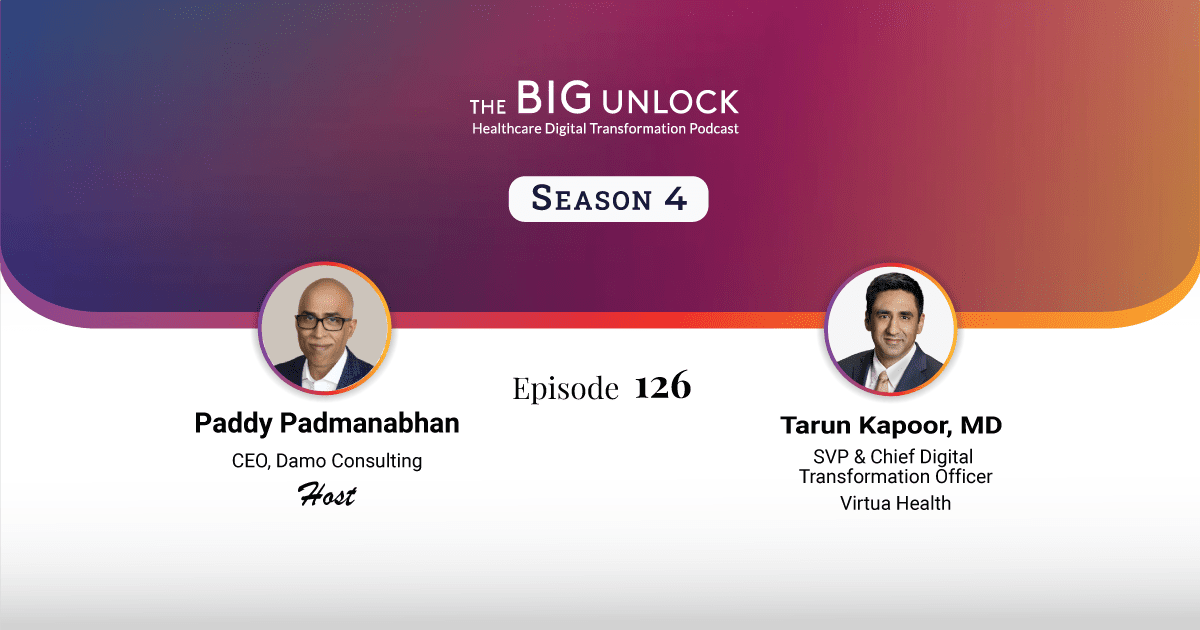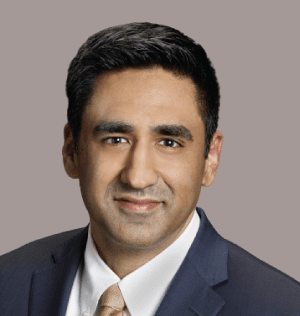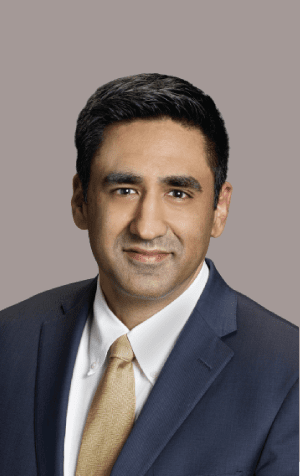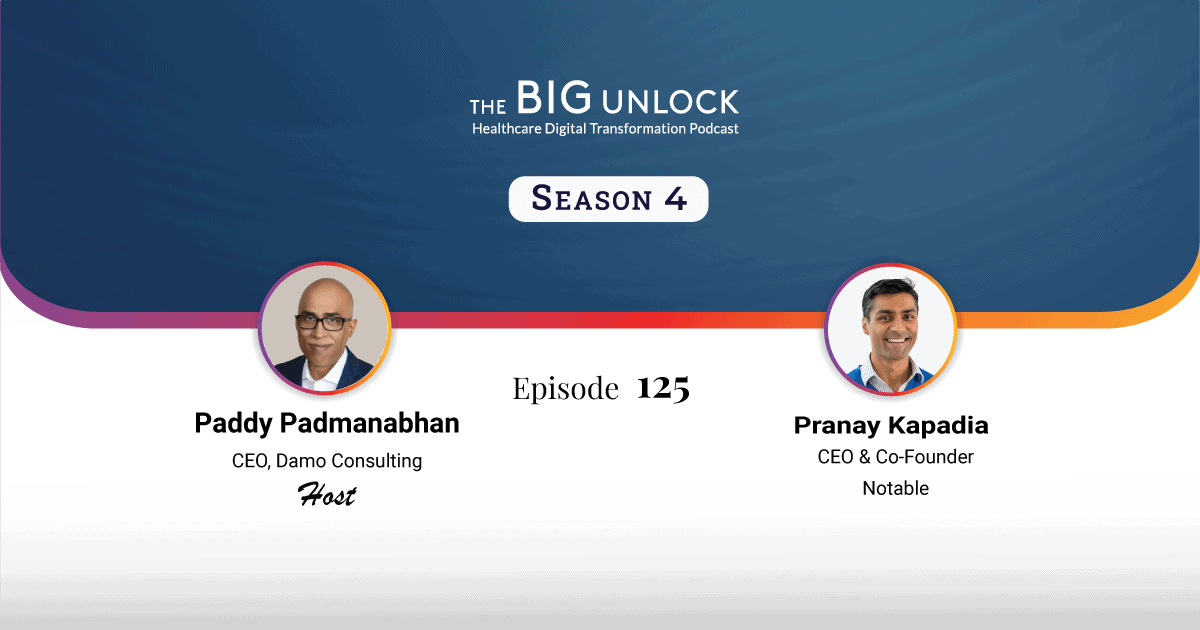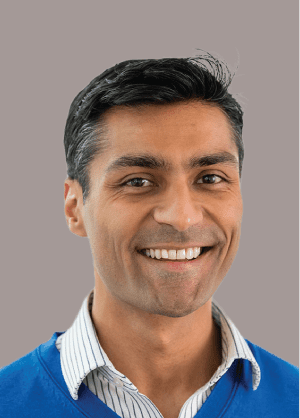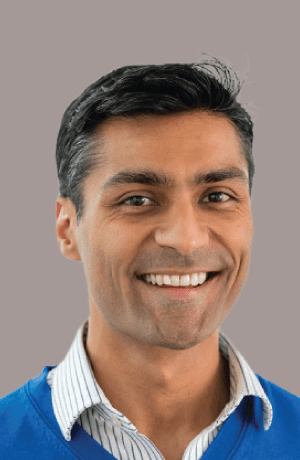Season 4: Episode #127
Podcast with Emily Kagan-Trenchard, SVP and Chief of Consumer Digital Solutions, Northwell Health
"The most important technology you can apply for digital health is human"
 Hosted by Paddy Padmanabhan
Hosted by Paddy Padmanabhan 
Share
In this episode, Emily Kagan-Trenchard, SVP and Chief of Consumer Digital Solutions at Northwell Health in New York, discusses a range of topics related to the new focus on consumers, patient data, technology, and analytics infrastructure required to drive consumer and patient engagement in this coming era of digital health.
Patient access is not just about capacity management and appointment scheduling but also about getting questions answered between different encounters with physicians, identity management for patients, and patient engagement. Emily suggests digital health startups take the time to do user experience research and strategic planning to understand the problem at the human level. Take a listen.
Show Notes |
||||
| 00:30 | Tell us about Northwell and your key priorities this year. | |||
| 05:51 | Tell us about some of the successes you've had and what you consider as unfinished business or work in progress. | |||
| 14:42 | In the context of healthcare, how is Northwell approaching this from a tech standpoint? How does the governance work to bring the tech and the program together? | |||
| 20:06 | How are the consumers responding to your recent cloud partnership? Where have you seen the impact of all your investments within your patient population? | |||
| 23:14 | You mentioned access as one of your priority areas. How do you tackle that and the enhanced digital abilities for consumers to take advantage of? | |||
| 27:55 | What do you think of the present moment for digital health technology companies in the context of all the pullback and risk funding? | |||
| 31:20 | What’s your advice for your peers in the industry who’re not as big as Northwell but equally interested in making the kind of progress that you've made? | |||
About our guest
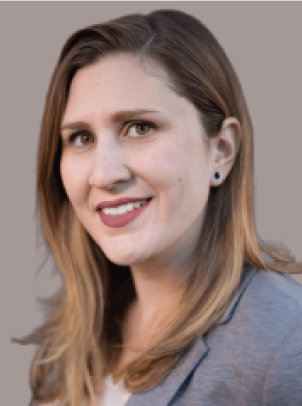
Emily Kagan Trenchard is a much-needed voice from within the American medical system: A spoken-word-poet-turned-healthcare-executive, she is on a mission to remix the human in healthcare, challenging entrenched assumptions about what it means to give and receive care in the digital age. As SVP, Chief of Consumer Digital Solutions for New York state’s largest health system, Northwell Health, Emily leads the digital patient experience teams that push the limits of how we use technology to make healthcare seamless and steeped in humanity, while keeping the company competitive at a time of radical change. The team's transformation efforts have given patients a single key to the digital front door - enabling online booking, bill pay, digital forms and consents, telehealth, test results and more, all from within an award-winning native app. Emily also launched Northwell’s first User Experience (UX) department to ensure that patient and staff perspectives drive the design of digital tools and systems.
Prior to joining Northwell Emily led web systems for New York City’s Lenox Hill Hospital where she led the development of many early consumer health tools, including the first-ever implementation of the ZocDoc scheduling platform for a hospital. Outlets ranging from The Wall Street Journal to TechRebublic and CMS Wire turn to her for a fresh perspective on emerging technologies and the future of healthcare. She is also a nationally recognized poet, essayist, and speaker; recent speaking engagements include the Cleveland Clinic’s Empathy and Innovation conference and WebSumit in Lisbon. Emily holds a master’s degree in science writing from MIT and a bachelor’s degree from the University of California at Berkeley.
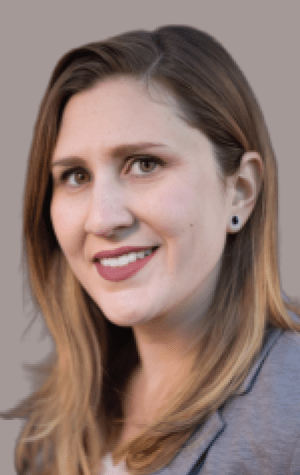
Emily Kagan Trenchard is a much-needed voice from within the American medical system: A spoken-word-poet-turned-healthcare-executive, she is on a mission to remix the human in healthcare, challenging entrenched assumptions about what it means to give and receive care in the digital age. As SVP, Chief of Consumer Digital Solutions for New York state’s largest health system, Northwell Health, Emily leads the digital patient experience teams that push the limits of how we use technology to make healthcare seamless and steeped in humanity, while keeping the company competitive at a time of radical change.
The
team’s transformation efforts have given patients a single key to the digital
front door – enabling online booking, bill pay, digital forms and consents,
telehealth, test results and more, all from within an award-winning native app.
Emily also launched Northwell’s first User Experience (UX) department to ensure
that patient and staff perspectives drive the design of digital tools and
systems.
Prior
to joining Northwell Emily led web systems for New York City’s Lenox Hill
Hospital where she led the development of many early consumer health tools,
including the first-ever implementation of the ZocDoc scheduling platform for a
hospital. Outlets ranging from The Wall Street Journal to TechRebublic and CMS
Wire turn to her for a fresh perspective on emerging technologies and the
future of healthcare. She is also a nationally recognized poet, essayist, and speaker;
recent speaking engagements include the Cleveland Clinic’s Empathy and
Innovation conference and WebSumit in Lisbon. Emily holds a master’s degree in
science writing from MIT and a bachelor’s degree from the University of
California at Berkeley.
Q. Emily, tell us a little about your role at Northwell and what are your key priorities this year?
Emily: I’ve been at Northwell for about 15 years. I started in the consumer-facing digital marketing division focused on websites, digital signage, and social media. About four years ago, the organization recognized that we needed to look at the consumer digital space with a little more focus and spun out a program that I ran. This was the Digital Patient Experience (DPX).
As it really gained legs, DPX and many other digital initiatives around the health system in other areas, not necessarily just consumer-facing, witnessed a growing recognition. What was happening in pockets previously for digital transformation needed to come together into something that was more consolidated so we could move to that next level of maturity. This past year, they created a division—Enterprise Digital Services—for which there are five functional leads: Clinical Digital Solutions, IT Operations, Business Analytics, Innovation, and then, Consumer.
My role at Northwell recently expanded and at Consumer Digital Solutions, we’re putting arms not only around the things I was doing for Digital Front Door as well as the consumer-facing websites and other digital touchpoints, but starting to say, “Where do we have initiatives where it’s critical that we start to think more holistically about how we’re connecting with patients and enabling care for them in a digital world?”
A good example of this is there are plenty of utilities out there for folk who want to gather information from our patients and some sort of patient-reported outcomes. We have a ton of different tools in the market that can do various versions of these questions. But how can we stop bombarding people with surveys and start being smarter about the utilities in which we gather this information so that we can truly exhibit a kind of institutional memory when someone tells us things?
When you start to think about those kinds of initiatives, they really broaden the perspective of the consumer’s role at the table. The real intention behind making a Consumer Digital Solutions title on par with a Clinical Digital Solutions title was so they could be equal partners in this conversation. Where do we have issues that we need to tackle together? The biggest challenge that we’re focusing on this year is, access. At its most base, it’s something around capacity management and making sure that people can get into the appointments when they need them with the providers that are best to see them in the right level of care for whatever’s going on. But access is about much more than that. It’s about getting questions answered, the back and forth in between encounters, getting prescriptions refilled, but asking a question about changing dosage. There are all the interim things that occur in the course of the space between an existing doctor’s visit which we can do so much better with different types of communication channels. Clearly, it’s a concerted effort on the operations and the consumers’ sides. That would be one example of something that has a number of projects that we’re now able to pull together into a more comprehensive program that we can run in this more agile and matrixed way.
This year, I have a really big focus on identity and identity management in order to form a real, truly master consumer index. When I say that, I do mean more than just patients. I mean caregivers, as well. We really need to have a centralized way of codifying information we know about people so that it can traverse more than just what’s in an EMR, across all sorts of engagement touchpoints. That’s a very big one for us.
The final piece that we’re spending a lot of time focusing on right now is where do we need to mature some of our channels. We’ve started with a lot of channels that are the standards— websites, apps, email, text messaging, etc.—but the chat functionality is huge. There’s so much you can do there with IVR and voice automation. It’s a lot of opportunity to not just have those types of channels in pockets for small bits of experimentation, but truly make them a part of core platform infrastructure—for the providers, staff, communications back to patients, and care givers. That’s a big rounding-out of our omnichannel portfolio, which we’re also focusing on this year.
Q. You’ve covered all the key elements that must come together seamlessly. Where are you in that journey? Tell us about your successes and what is work in progress.
Emily: There’s the notion of orchestration writ large. Then, there’s the notion of in-specific omnichannel orchestration. Let’s take the larger concept, first. When we’re talking about this type of orchestration, sometimes we do truly mean it in the “Do you send the text message before the email?” sense. If they open the email, do you even bother with the text message in that sort of a comms level orchestration? If a foundation wants to send something out asking about a donation, don’t send it to this person who just had a patient complaint. There’s that level of orchestration, which maybe is a level one of just understanding who’s trying to talk to the patient at any given time. Is it appropriate? Whose “go” is it?
The other type of orchestration we’re starting to see is the importance of trying to orchestrate—in-patient or in-person engagements with online engagements. Where do you have someone starting a task but not finishing it that you pick up now in an office? Where do you start a task in an office that now you complete online? Where do you have a customer service call that came in and then, follow-up with a billing question? When it hands off to billing and their rate, can the office know about that the next time they show up there? That’s an orchestration around engagement that really needs to traverse the online and offline worlds. I’d say that is the place where we know the work to be done. It’s truly about putting in the tools to enable that to occur and you can start in some places.
What we’ve really done then, is to say, “How can we do this at the customer service and call center levels, first?” I think that’s one of the easier places to start to go back and forth at. In health care, especially for those of us who have ambulatory networks, you can consider the front desk as a part of that, too. That truly becomes a customer service desk as well as a call center touchpoint. How do you at least get those folk to understand where someone last left off?
This gets into broader CRM strategy, now. This is obviously not just what happens in marketing. This is a larger CRM philosophy. That’s a really important concept and if we bounce off of that one, one click further out from what you would traditionally consider, you can start to do that with providers as well.
When you start to think about your referral management strategy and your network growth, how do you take this concept of consumer relationship management and think about your consumer as your providers? As people who you want to grow relationships with to find patterns of referral, improve capacity, and improve collaboration, can you take those utilities, use them on behalf of a provider network and take the connective threads you build there to unlock capacity, across network support for complex patient care?
I’d say the next generation of where our heads are at in terms of taking an incredible CRM strategy which we’ve really matured via our marketing department and expanding that concept out for that online offline transition as well as over into the provider space is really the bigger orchestration question. You can cascade that into a whole lot of other places.
Q. What are the basic enablers that you absolutely need to have in place before you can really make any of this a reality?
Emily: I would say patient identity is one of them. For instance, do not click $200 first steps, etc. Then, there’s nuance within that. When we start with patient identity, we ask—Do you even know who is your patient? Do you have an email address for them? Do you have a cell phone on file? Do you know if it’s working? Do you have the right consents and permissions to communicate? That’s even before you talk about preference. I prefer a text message over an email, so, that’s just on the individual patient level, but truly, where my focus and interest lie is actually not just for the patient but for the caregiver, too.
That’s where you start to get interesting because you will now want to have an identity that is not just for the people who have an MRM. You want to have an identity for anyone who comes and is responsible for someone’s care in your organization in order to communicate. Start with your identity and mature your concept so you can build a larger framework. Let’s say you’ve got the identity piece locked or you say, “You know what? I got it for patients.” Let me just start there.
Second, folk really need to be sure that they have some sort of communications backbone that’s going to allow you to do omnichannel. Let’s just start with email and text message. There’s a lot more channels you can talk about but let’s start there. When you’re talking about any CRM worth its salt, it’s going to have email and text messaging capabilities. The power is not whether or not you can send any one of those kinds of cards. The power is in deciding which one to send and when.
When you send an email, do you need to send a text? The name of the game here is really trying to find economies, scale, and cost efficiencies in that communication. If I send someone an email, ask them to confirm that appointment, and I don’t have to send that follow-up text message, I might have saved myself $0.04 a message. That’s not a big deal on an individual level, and way cheaper than getting a cancelation certainly to send that out. But I’d rather not spend anything if my email costs are already baked into my CRM contract. If I’m not responding with that automated text message, perhaps, I’m going to an IVR or sending them to a chase list where I have a human pick up the phone to call. If I can handle all that before a human pick it up, even better.
What you’re really looking for then, is something that’s going to have that sort of dynamic intelligence. Someone responded. Not only did I fire off a message, but here’s what happened to that message when it went out into the world. Here’s how I’m going to change my messaging behavior based on that input. That can be on a case-by-case basis for an individual or that can be an aggregate as you learn about what helps campaigns perform better. That can be on a cohort basis when you start to identify different groups of people who should have different messaging cadences.
But that is really where you can start to do level one multichannel communication customization and not just recognize the benefit of having any digital comms, but having those that can be intelligent, learn, and be dynamic with one another to truly optimize your spend in that area.
Q. In the context of healthcare, how is Northwell approaching this from a tech standpoint? How does the governance work to bring the tech and the program together?
Emily: Let’s talk about what tech pieces are there and then, we can ask, what this may mean for one of the heads to come in and be involved. When we talk about having that sort of backbone, who are we talking to? Where are the data elements coming from? Obviously, my partner who leads the Business Intel and Analytics Division is critical because we’re looking at all these different data sources.
From a marketing standpoint, at a healthcare institution, not only are you going to have sources such as, your EMR and reg systems, etc., but also, third-party data. When we look at our marketing utilities, that’s an important thing. We need a little bit of Church and State from first-party and third-party data. So, what marketing does is reach out to the addressable market which is different from those who might already have an MRM, be engaged or are caregivers. We need to find ways to have the right levels of not just governance but segmentation in the data domains.
Also, we need to make sure that when we’re thinking about what traverses where we understand the intended use of the data so that we’re using things in ways that are appropriate, aligned with people’s consent especially, with all of the new laws around like GDPR and Right to be forgotten, etc. There are certain types of information that can be forgotten and others that can’t because of regulations. Level one then, is all about—Do you know your sources? Do you know how to segregate your sources? Do you know how to clean them? Do you know how to map, match, and do them?
When you’ve got these data elements, you want to talk about doing fun things with that. How do you mix and match? How do you add additional data from different domains? How do you do the analyses that put segmentations on top? Or do predictive modeling on top of these things? That’s where you can take data to the next level. For that, what you want to do is keep things tight and clean in the beginning. Then, when you want to do the fun stuff, you want to be able to bring in as many different variants and flavors as possible.
Our philosophy and strategy are heading towards—and again, let me say that we have CRMs today, which do a really fantastic job and are pretty mature as things are considered—a Consumer Data Platform (CDP). This is really an omnivorous kind of platform where you don’t have to have structured data, necessarily. You don’t need to know what you’re going to put into it to put things in and then, crosswalk, and make it referenceable and available to a number of different end consumers. That’s where our roadmap is taking us. Getting to a CDP is a 2023-24 initiative for us.
When you talk about a CDP, you talk about infrastructure. Here, I would involve my partners from IT because we really do need this to be a backbone that different end consumers—our lab system, call center, marketing for example—can reference, put information back into, gain insights for the data science teams, and apply back out. That’s where we really need to ensure that they’ve got a hand in making this a truly functional utility inside the organization and it does become an engine for us.
Now you’ve got the clinical and innovation pieces, so, of course you want to do data science and interesting data products. You can stand it on the backbone, take the same types of layers of intelligence and say, “Okay, talk to me about someone, the social determinants of health. Overlay that with these risk factors coming out of the EMR and put together an engagement model that’s customized specifically for this person in this neighborhood.” For that true one-to-one, you’ll need to be able to overlay the data sets which can then talk and learn from one another, even though their governance as source data points might be in different areas. That’s why we talk about domains. It starts to get into some of these concepts around data mesh that a lot of us are starting to think about.
That would really be the evolution of where we’re thinking towards. How we really need all these different areas within an enterprise digital view to be sure that we’ve got the parts and pieces required to not just do the basics, but to make this one of the most transformative engines that we can have inside a health system.
Q. Data infrastructure is critical and Northwell just announced a cloud partnership to power some of this. How are the consumers responding to it? Where have you seen the impact of all of your investments within your patient population?
Emily: We’ve had a number of different areas where we’ve taken digital tools and made self-service capabilities that are the bread and butter of any first engagement. I’ll talk a little about where you see things that really end up feeling a little bit more game-changing.
The first is probably around online payments. We think about paying every other thing in our lives, online. Not only do we think about the ability to pay it because you don’t have to sit there, find the checkbook, and write something out but who even has a checkbook anymore? Write in the credit or get on the phone.
But the minute that you enable somebody to pay a bill online, you also have the ability to pull other bills in so that you can roll up charges. You have the ability for people to do it while they’re in a meeting at work or while they’re bored because it’s right there. And you have the ability to put in front of people different payment options. So, if they’re concerned or perhaps embarrassed about struggling to pay something and if you can enable right then in there an option to sign up for a payment plan, you’re using a degree of discretion with something that is deeply emotional, personal, and quite frankly, a huge pain points inside of healthcare, to help people meet their financial responsibilities.
We’ve already seen about 30% of all bill payment volumes offloaded from phones and mail on to digital. With that, we’ve seen a commiserate increase in the speed to pay. By about three weeks, there’s greater speed to pay through digital channels. We have seen a huge uptick in the number of people who are self-servicing on payment plans, which they used to have to call a Call Agent to get set up. We have about 85-87% patient satisfaction with the entire experience. If you think nobody’s happy to pay a bill rate for health care, especially when you have 87% patient satisfaction in something that used to be the primary complaint for the organization, it’s a huge success.
Q. You mentioned access as one of your priority areas. How do you tackle that with all the infrastructure created and the enhanced digital abilities for consumers to take advantage of?
Emily: When you talk about online scheduling, the very first thing to consider is, “Can you have those provider templates made available for online scheduling?” We’re in an effort right now where we are looking at a lot of providers and trying to make sure that just because they have it available doesn’t mean that there’s a spot for the next three weeks. What do we do in order to get that availability to be much sooner so that when you’re scheduling, you’re not clicking the forward button four, five, or six times before you find the next available date and time to see the provider you want to see, online? Of course, this presumes you can book online. But where do you go from there?
When we talk about freeing up capacity for providers, part of what we want to talk about is, what really needs to be an in-person visit versus what can be telehealth. This is the world after the pandemic where telehealth is a foundational part of how people are going to get care and we’re learning how best to use it. Where are the opportunities to actually say, “The provider doesn’t have an in-person visit, but you can do this one via telehealth?” We’re looking at opportunities where we can actually take telehealth volumes, roll it with in-person volumes, and see what kinds of questions you can ask ahead of time in that scheduling flow to identify patients who are good candidates for a telehealth visit instead. Again, we’re unlocking some of that capacity. We’re also taking advantage of telehealth by asking, “Where do you have patients who are coming in for certain things for which a telehealth consult is maybe most appropriate and it doesn’t need to be with their specific doctor?
We have two programs running right now. The first is called ED on Demand, essentially an after- hours program for our Emergency Departments. There’s a rotating call schedule of ED physicians who can take urgent matters in off-hours so you don’t actually have to go into an urgent care or into an ED, but you can talk with an emergency medicine professional via telehealth and really get that assessment before you go anywhere else. That is a great way to take what otherwise may be urgent calls into primary care, stops at the urgent care or into the emergency departments themselves, and take a first round pass of that, virtually. Patients love it, providers love it. It really is a win.
The variation on that is what we’re doing right now. We call it, Same Day Sick. If you’re sick and need to see a provider, today, is it because you actually need to see your provider and they’re only the ones who really deeply understand your case? Or is it a UTI and you just need to get a script? Is it a sinus infection? Is it just a cut? Do you need to know if you can put the antibiotics on? It’s the same concept of a virtual pool of providers who can take calls for Same Day Sick. This is rolling out in our primary care division and it’s fantastic because it’s taking this volume which otherwise would have gone into the pool for the patients who need to actually get in for maybe a true in-person same day visit or an annual well and whatever else is taking up our capacity for our primary care network. It’s offloading some of that volume into a care setting that is still appropriate for the need, but takes advantage of telemedicine in ways that are that next turn of the crank. We’ve got these tools all built and up and running since the pandemic.
Q. Great examples. Obviously, a lot of these solutions are enabled by technology providers that cover the whole spectrum—EHR vendors, enterprise class platforms, CRMs etc. How do you tap into innovation in the marketplace? What do you think of the present moment for digital health technology companies in the context of all the pull back and risk funding?
Emily: First, we have a new person starting on August 4 to lead our Innovations pillar. Rebecca Call will be joining us from M.D. Anderson, formerly at UPMC. We’re super excited to have an incredible innovator who, I think, will take our innovations approach to the next level. What does that mean? Where do we want to go? We definitely have a huge appetite for investing in new technologies. We have spun companies out of our own employee solutions. We do a lot of customer development here inside of Northwell, too, but I think that the name of the game right now is getting specific about what problem you’re trying to solve because everybody and their brother has gone through these consolidations. Everybody in the bubble is going to promise they do everything under the sun. Where do you see vendors that are going to add, quite frankly, as you said, niche, specific, enhanced capabilities that you can plug into existing platforms? The number of people who are going to be running health systems without some base platform infrastructure is shrinking by the day, so, if you’re there looking at these solutions and your answer is, “We’ll just rip and replace yours and put in mine, (whatever the product’s going to be),” it’s a non-starter.
If you’re talking instead about coming with products that have very mature SDK and APIs, logic engines which can be consumed by other delivery endpoints, and nestle well into other existing platform infrastructures, you’re going to see a whole lot of excitement to take those and really extend these platforms that we’ve all invested in way past the speed at which those vendors can actually move. We can move internally, especially in places where there are types of capabilities that are truly commodity in other industries. We can take best-of-breed and bring it back over into health care. That, to me, is a really exciting space. I think it’s really about a retooling of where these companies were headed in the past, which is, everybody wanted to be everyone’s everything. Everybody wanted to be your full engagement suite and solve every problem under the sun for you. But what’s your core workup? What is your core capability? Where is truly the thing that differentiates you? How do you make that as light, fast, and flexible so that you can go and play with these organizations in recognizing full well that they have platforms that you’re going to seek to accelerate?
Q. What’s your advice for your peers in the industry who’re not as big as Northwell but equally interested in making the kind of progress that you’ve made?
Emily: I think the most important technology you can apply is human. When you take the time to actually undertake user experience research and strategic planning to understand the problem at the human level, take that proverbial step back without getting excited just by what the technology is going to offer and not just get excited about what all of your peers are doing, but slow down and genuinely say, “What am I hearing from my staff? What am I hearing from my patients? Where can I make the biggest improvement?” then, nine times out of ten, you’re already going to have the tech in hand.
It’s just going to be about optimizing workflows, lighting something up that you hadn’t turned on before, and solving problems that might not be sexy. But they are the ones that are going to make the biggest impact. If you start there, you are going to gain the traction you need to then, go back and ask for the investments for the bigger, sexier things.
It all starts with human centered design. If you don’t have a human centered design practice, or one that involves that research and analysis into your strategic planning, and particularly the product planning for these sorts of MVP’s—your first crack at these things—do yourself a favor and get that baked in. Then, what you really start to do is evidence-based transformation. That’s what your senior leadership is going to want to hear and see when you’re proving the value of these efforts.
We hope you enjoyed this podcast. Subscribe to our podcast series at www.thebigunlock.com and write to us at info@thebigunlock.com
Disclaimer: This Q&A has been derived from the podcast transcript and has been edited for readability and clarity
Recent Episodes
About the host
Paddy is the co-author of Healthcare Digital Transformation – How Consumerism, Technology and Pandemic are Accelerating the Future (Taylor & Francis, Aug 2020), along with Edward W. Marx. Paddy is also the author of the best-selling book The Big Unlock – Harnessing Data and Growing Digital Health Businesses in a Value-based Care Era (Archway Publishing, 2017). He is the host of the highly subscribed The Big Unlock podcast on digital transformation in healthcare featuring C-level executives from the healthcare and technology sectors. He is widely published and has a by-lined column in CIO Magazine and other respected industry publications.
